Association between Temperature Changes and Cardiovascular Mortality Risk in A High-latitude City in Northeast China*
LI He Ping, MA Yu Xia,#, QIN Peng Peng, WANG Wan Ci, LIU Zong Rui,ZHAO Yu Han, and YANG Li Jie
In recent decades, regional and global climate change has increased the frequency of extreme weather events (e.g., hurricanes, cold spells, and heat waves).The diurnal temperature range (DTR)and temperature change between neighboring days(TCN), which are indicators of short-term temperature shifts, have been found to be significantly associated with cardiovascular morbidity or mortality[1].A worldwide study on the effects of temporal changes on mortality burden in 10 countries found that a negative impact of high DTR on mortality in a short time and a 10 °C increment in DTR increased the risk of overall mortality by 3.10%[2].Another study on the link between TCN and multiple disease mortalities in the United States also revealed that the cumulativeRR(relative risk) of extremely positive TCN significantly affected cardiovascular mortality with anRRof 1.52(95%CI: 1.40–1.65)[2].Given that most relevant studies were confined to large central and eastern cities in China[1,3], the generalizability of the results remains uncertain.Therefore, in the current study,we used the distributed lag non-linear model(DLNM) to explore the specific relationships between DTR/TCN and cardiovascular mortality risk and evaluate the health effects of different patterns in Harbin, a high-latitude city in China.The relevant findings of our study may provide evidence for medical meteorology research at high latitudes in China and provide a theoretical basis for local services.
Daily cardiovascular mortality in Harbin during 3 years (from January 1, 2014 to December 21, 2016)was obtained from the Harbin Center for Disease Control and Prevention.The causes of death were coded according to the 10th edition of the International Classification of Diseases (ICD-10),containing 10 specific cardiovascular diseases, from I00 to I99.The main daily meteorological elements were obtained from the Harbin Meteorological Bureau, and the main daily air pollutants were collected from the Harbin Environmental Protection Bureau.
Daily death caused by cardiovascular disease is a low-probability event, which is considered to satisfy the Poisson distribution.In the present study, the natural cubic spline function of the DLNM was used to evaluate the effects of DTR and TCN on cardiovascular mortality across different sex groups and periods with lag days[4].The specific model formulas are
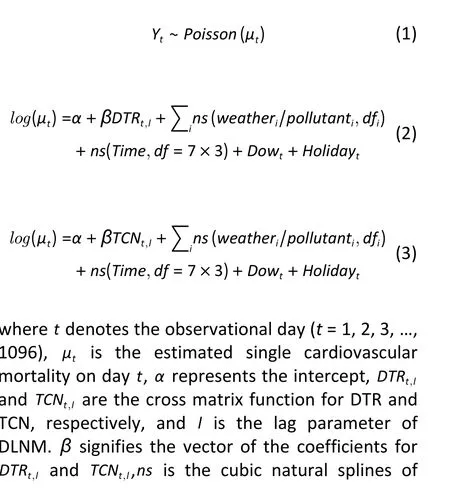
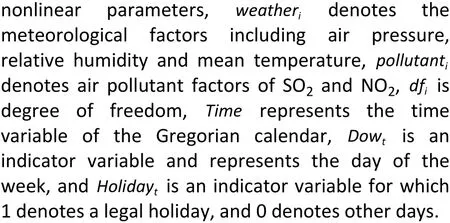
In light of extensive previous research, the degrees of freedom (df) for all meteorological and pollutant parameters were set as 3, and the df in the cross matrix of DTR and TCN was selected as 4 in this study[5].Environmental factors were selected based on the Spearman’s correlation with cardiovascular mortality (Supplementary Table S1, available in www.besjournal.com).To eliminate long-term trends and seasonality, the df of time was seven per year with a maximum lag time of 10 days.For explanation and quantification, we took the 5th percentile as the lowest extreme value and the 95th percentile as the highest extreme values for DTR and TCN.In addition, the records were divided into diverse subgroups with respect to sex (male and female), and according to monthly average temperatures in Harbin[6], we stratified the entire study into three periods: full year, hot season (June to August), and cold season (November to March of the following year).A two-sample Z-test was conducted to examine whether the differences between the subgroups were statistically significant(see Supplementary Table S2, available in www.besjournal.com).All the mathematical analyses were performed using R language (version 4.2.2,URL: https://cran.r-project.org/), and DLNM was based on the “dlnm” package (version 2.4.7).The two-sided test was applied to all the statistical results, andP< 0.05 was deemed to be statistically significant.
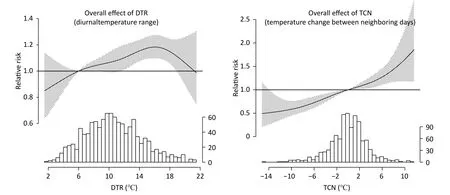
Figure 1.Cumulative RRs over 10 days on the cardiovascular mortality with the frequency distribution histograms of DTR (diurnal temperature range) and TCN (temperature change between neighboring days)in Harbin, China, from 2014 to 2016, with the reference values of 6 °C and 0 °C, respectively.
The daily cardiovascular mortality was 71 per day over the full year; 43.11% of cases were in the cold season (74 per day), and 23.02% of cases were in the hot season (65 per day) (Supplementary Table S3,available in www.besjournal.com).Cardiovascular mortality was higher among males than females, and in winter than in summer.The average TCN value recorded in different stages were all approximately close to 0 °C, and the mean DTR value in the cold season (11.20 °C) was slightly higher than that in the hot season (9.20 °C).The average daily concentrations of NO2(62.80 μg/m3) and SO2(79.80 μg/m3) in the cold season were much higher than those in the hot season when NO2were 34.70 μg/m3and SO2were 8.10 μg/m3.The timeseries analysis of calendars for the daily average DTR and TCN from 2014 to 2016 (S1) showed that the high values of DTR were essentially distributed between January and May, and the low values were essentially distributed between June and September.In other periods, monthly variations in the DTR values fluctuated within a limited range.The value of TCN varied less from June to September and remained around 0 °C, and in other months, the high TCN values were predominant, while the low levels were less frequent.The differences in the daily and weekly changes in the indicators were not significant.The temporal distribution characteristics of DTR and TCN may be related to the local climatic characteristics and geographical background.
As shown in Figure 1, the high frequency of DTR was mostly distributed in the range of 6–14 °C, while that of TCN was more frequently in the range of-2–2 °C.The 10-day cumulative risk curve of both DTR and TCN demonstrated a consistent upward trend as temperature changes increased, with a peak value of 1.17 (95%CI: 1.08–1.26) at 16 °C for DTR and 1.86 (95%CI: 1.18–2.92) at 11.50 °C for TCN.High DTR and TCN values represent more dramatic short-term temperature changes that could have a more significant impact on human health.Thus, high DTR and TCN levels contributed to a greater effect on cardiovascular mortality than low levels.
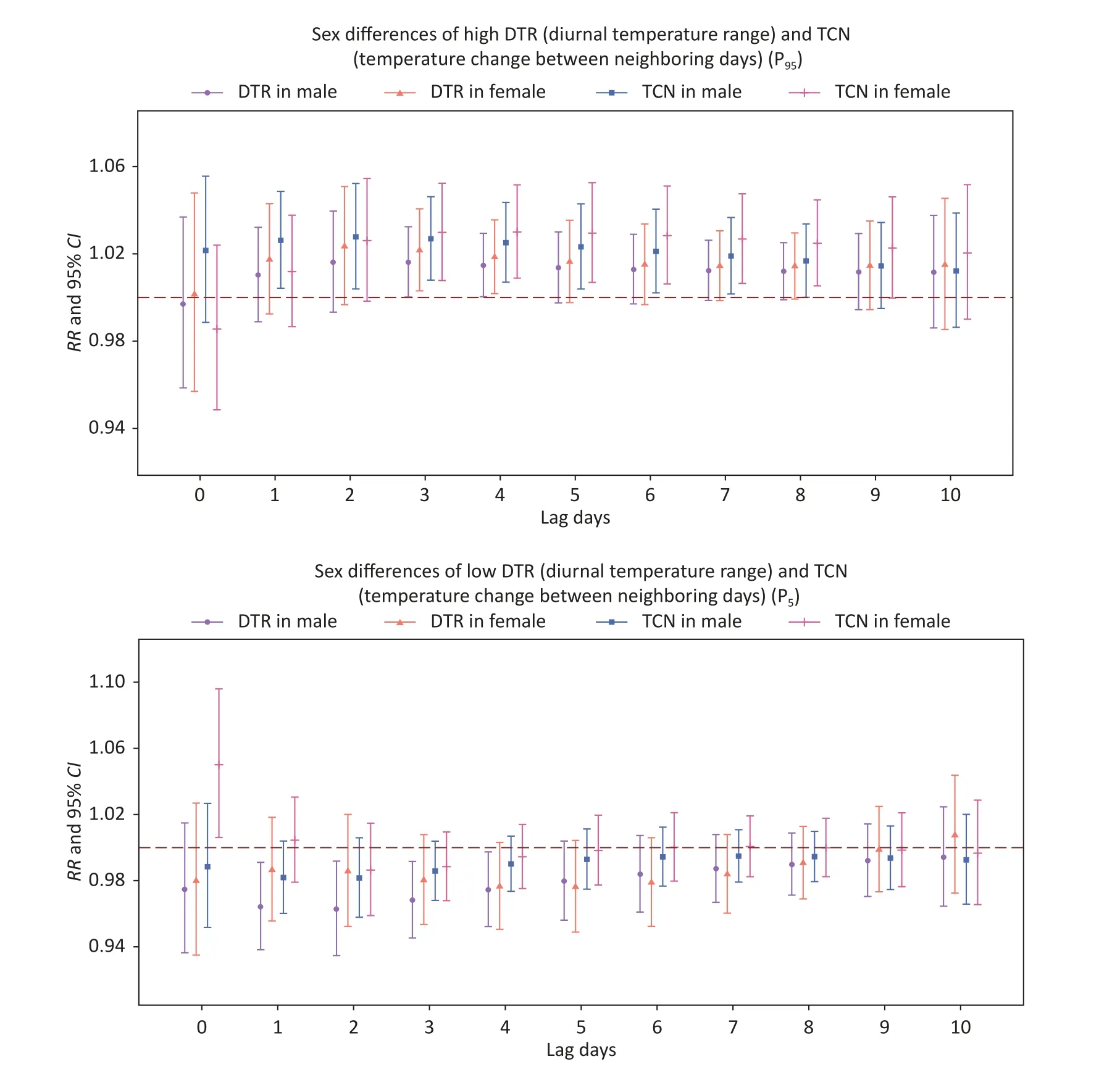
Figure 2.Effects of extreme high (P95) and low (P5) DTR (diurnal temperature range) and TCN(temperature change between neighboring days) on the gender-specific cardiovascular mortality in Harbin, China, from 2014 to 2016.
Sex differences at high and low DTR and TCN are shown in Figure 2.Generally, the averageRRs of the DTR and TCN with high levels of sex were greater than those with low levels on each lag day.TheRRs of females and males at high levels (P95) of DTR and TCN initially increased, and then decreased with lag days.TheRRs of DTR in males and females increased to a maximum on the second day (lag 2), with values of 1.02 (95%CI:0.99–1.04), 1.02 (95%CI: -1.00–1.05), and 1.03(95%CI: 1.00–1.05), respectively.The largestRRfor TCN in males was 1.03 (95%CI: 1.01–1.05) on the fourth day (lag 4).In addition, theRRof TCN in females had a maximum value of 1.050 (95%CI:-1.00–1.10) on the same day; otherRRvalues were not significant at low levels.The cumulative effects(Supplementary Table S4, available in www.besjournal.com) showed that theRRvalues of high DTR and TCN were greater in females than in males, indicating that the females were more vulnerable to both DTR and TCN than males.This phenomenon might be linked to individual physiological structures, immune functions, and hormone levels, such as the specific physical mechanisms in males, which prompted them to be more resilient to environmental temperatures than females, and the absence or deficiency of this mechanism caused females to be more susceptible to temperature changes[3].
Figure 3 shows the effects of low (P5) and high(P95) DTR and TCN levels on cardiovascular mortality under seasonal stratification.TheRRs of low DTR and TCN showed no apparent effects on cardiovascular mortality in any season.In the entire year, theRRs corresponding to a high DTR and TCN revealed a consistent pattern of variation and reached a maximum on the second day (lag 2).In the cold season, the effects of temperature changes were more hysteretic; theRRvalues for all groups increased gradually with lag time, and the maximumRRs occurred at lag 10 for high DTR and at lag 7 for high TCN.In the hot season, the effects of temperature changes were more transient; the largestRRs occurred on the same day and thereafter decreased with lag days.TheRRvalues of high-DTR were higher in the hot season, whereas those of high-TCN were much greater in the cold season(Supplementary Table S4).Winter heating in northern cities and vulnerability to thermal adaptation might lead to an underestimation of the effect of cold temperatures on cardiovascular mortality.The estimated effects of TCN on cardiovascular mortality were greater than those of DTR.In general, people, especially office workers,stay indoors during the time of day when the temperature drastically changes, which may result in an underestimated pathogenic effect of DTR[7].The heat island effect caused by the urban and suburban temperature differences may enhance the health effects of DTR and TCN.Furthermore, a dramatic inter-day change in temperature could increase the adverse effects of average temperatures on mortality, and this additional impact carried by average temperature would, in turn, amplify the effect of TCN on mortality[8].
The underlying physiological mechanisms of DTR/TCN on daily cardiovascular mortality remain unclear.A reasonable explanation is that sudden changes in ambient temperature surpass the limits of the body’s initial tolerance; automatic temperature regulation systems cannot adapt well to such a variation in the environment in the short term, leading to an increase in blood pressure,immune reaction, and inflammatory response while affecting many other physical functions[9].Other potential pathogenic factors, including the increase of superficial blood circulation, hypotension, salt depletion, and dehydration, would be an additional burden to the cardio-cerebral-vascular system,which might ultimately cause the occurrence of stroke or myocardial infarction[10].
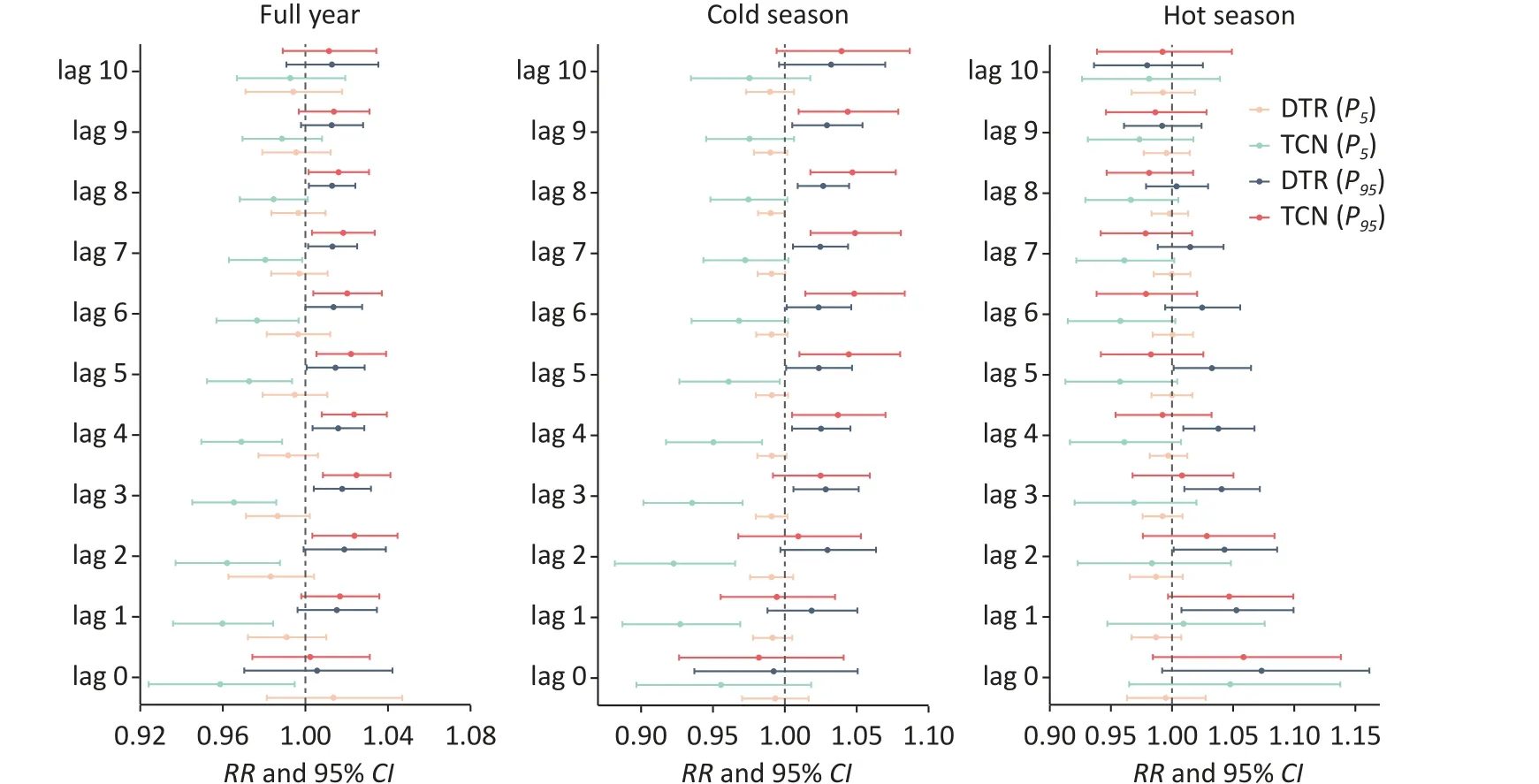
Figure 3.The effects of extreme low (P5) and high (P95) DTR (diurnal temperature range) and TCN(temperature change between neighboring days) on cardiovascular mortality under seasonal stratifications.
The current study has several limitations.First,owing to the large regional differences in population vulnerability, climatic conditions, and socioeconomic status, the findings of this study should be generalized to other regions of China or the world.Second, the collected daily cardiovascular mortality data were confined to selected hospitals and did not include more patients; therefore, the impacts of temperature changes on mortality were biased and probably underestimated.Additionally, individuallevel factors, such as occupation, education level,and economic conditions, were not considered; the use of air conditioning reduced the temperature differential effect, while outdoor workers could bear greater risk.
The authors declare no conflicts of interest.This article does not contain any studies with human participants or animals performed by any of the authors.
&These authors contributed equally to this work.
#Correspondence should be addressed to MA Yu Xia,Tel: 81-931-8915728, E-mail: mayuxia07@lzu.edu.cn
Biographical notes of the first authors: LI He Ping,male, born in 1998, Master, majoring in the health effects of ambient temperature; MA Yu Xia, female, born in 1974,Professor, majoring in weather and climate effects on health.
Received: June 25, 2023;
Accepted: August 22, 2023
 Biomedical and Environmental Sciences2023年11期
Biomedical and Environmental Sciences2023年11期
- Biomedical and Environmental Sciences的其它文章
- Decontamination Efficacy of Disinfection and Doffing of Medical Protective Clothing: A Combined Mannequin and Personnel Study*
- SARS-CoV-2 lnfection Risk Factors in Beijing during November 2022: A Case Control Study*
- The Value of Prealbumin and its Combination with NT-proBNP for Predicting in-hospital Mortality in Patients with Heart Failure: Real-World Research Based on Propensity Score Matching
- Mendelian Randomization Analysis to Analyze the Effect of Emergency Caesarean Section on Different Allergic Diseases and Related Blood Markers*
- Effects of Differential First-Line Antiretroviral Therapy (ART)Regimens on Mortality among HlV/AlDS Children in Southwest China: A 15-year Retrospective Cohort Study*
- The Psychosomatic Traits of “People with the Five Elements in Traditional Chinese Medicine”: A Qualitative Study*
